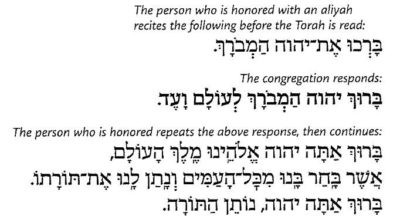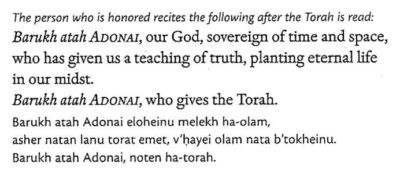This guide is designed to help you to become more familiar with being honored with an Aliyah (literally, “an ascending”) to the Torah.
The practices outlined here are the same during Shabbat, Festivals and all weekday Torah services. We sincerely hope that by providing you with more information about our congregation’s traditions, you will become more comfortable with having an Aliyah, and therefore be able to make the very most of this sacred experience!
To download a text copy of the Torah Blessings as they will appear on the Bima, click here.
To download audio of the Torah Blessings, click here.
As a Conservative synagogue, we ask that men cover their heads when they are in the Sanctuary or the Chapel, and are expected to wear a Tallit (prayer shawl), so no special care is needed when they are called for an Aliyah.
Women are encouraged (but not required) to cover their heads in the Sanctuary or in the Chapel, so if you are going to be called for an Aliyah, please make sure you have a kipah or a lace head covering. Please put the head covering on before you are called up. For your convenience, head coverings and hair pins are available at the entrance of the Sanctuary or the Chapel.
According to tradition, the congregation should be able to clearly hear the recitation of these blessings, thus we ask that you practice reading the blessing in advance so you can do it to the best of your ability. If you have questions or need support, please contact our Rabbi. A large and easy-to-read copy of the blessings in Hebrew and in English transliteration is readily available on the Amud (Torah reading table) just to the right of the Torah.
When you are called, approach the Amud (Torah reading table) by the most direct route from your seat.
You will stand to the right of the Torah reader, facing the congregation. The Gabbai (assistant to the Torah reader) will call you by name to the Torah, but may not know your Hebrew name in advance, so you should be prepared to give your name in Hebrew in the following way: your name in Hebrew ___________, ben/bat (son/daughter) followed by your father’s Hebrew name ___________ and your mother’s Hebrew name ___________. [Example: “Yitzchak ben Avraham v’Sarah” would be the Hebrew name of “Isaac son of Abraham and Sarah”]. You should also add “Ha-Kohen” or “Ha-Levi” if you know you are a Kohen or Levi.
Once called, if you are wearing a Tallit, loosely wrap some of the knotted fringes (Tzitziyot, plural of Tzitzit) on your finger or just hold a corner of your Tallit; if you are not wearing a Tallit, hold the sash that is used to tie the Torah that you will find on the reader’s table or that the Gabbai will hand to you.
The Torah reader will then indicate with the Yad (Torah pointer) where the reading begins. You should then touch near that spot with the Tallit, Tzitzit, or sash. When you “touch” the Torah, you should never actually touch it with your fingers since the oils from your fingers can physically degrade the written letters of the Torah. In fact, you don’t want to actually touch the letters even with the Tallit or the sash. It’s best to touch the white space between columns just next to where the Torah reader has pointed. After touching the Torah, you then kiss the Tallit or the sash. Sometimes if there is a large group, one person will touch the Torah and then offer the Tallit or the sash for others to kiss.
First, stand directly behind the Torah and hold both Atzei Chaiyim (Torah “handles”, literally translated as “Trees of Life”) while chanting the blessings, which are provided on the large laminated sheet on the Amud (Torah reading table).


The Atzei Chaiyim (Torah “handles) may also be slightly lifted on the last two words of the blessing (“…note in ha-torah”). The holding and lifting traditions symbolize taking possession—that we are willingly accepting the Torah that God gives to us. Remember, also, that you repeat “Baruch Adonai ha-m’vorach le-olam va’ed” after the congregation responds with these same words. Following that, you then complete the remainder of the blessing.
You then move a step or two to the right to make room for the Torah reader.
The scrolls will then be slightly unrolled. As the Torah is read, follow the words as they are pointed to with the Yad. You should continue to hold onto one of the Atzei Chaiyim (Torah “handles) that is closest to you as the reading continues to keep the scroll unrolled.
When the reader finishes reading the concluding verse of that Aliyah, he/she will point out the last word with the Yad.
Again, take the Tallit, Tzitzit, or sash and touch in the column adjacent to where the reader points. Then kiss the Tallit or sash, roll the scrolls together, hold both Atzei Chaiyim (Torah “handles), and recite the second blessing (on the laminated sheet on the reader’s table).


Again, you may gently lift the Atzei Chayim on the last two words (“…notien ha-torah”), as explained earlier.
Historically, the person having an Aliyah was actually responsible for reading the Torah. In gratitude for the person reading “for them,” following the concluding blessing the person having the Aliyah is encouraged to say “Yasher koach” to, and shake the hand of, the Torah reader.
If your Aliyah is not the very last one, you then move around toward the right side of the Amud and stand next to the Gabbai for the next Torah reading.
You remain as a symbol of your reluctance to leave the Torah. Now, you follow the Torah reading in the Chumash (book that contains the Torah and Haftarot with English translation and commentary). When you are finished on the Amud, or if your Aliyah is the last one, exit from the side where you were standing. It is customary to exchange short greetings with the Rabbi, the Gabbai, and/or other individuals sitting on the Bima, and then walk back to your seat in the Sanctuary or the Chapel. Some follow the custom of taking the longest route back to their seat as an act of prolonging the experience and further demonstrating their reluctance to leave the Torah.
When you complete your Aliyah, some congregants may congratulate you by saying “Yasher koach” which means “May your strength be firm” or “More power to you.”
The proper reply is “Baruch tih’yeh” which means “May it be for a blessing.”
